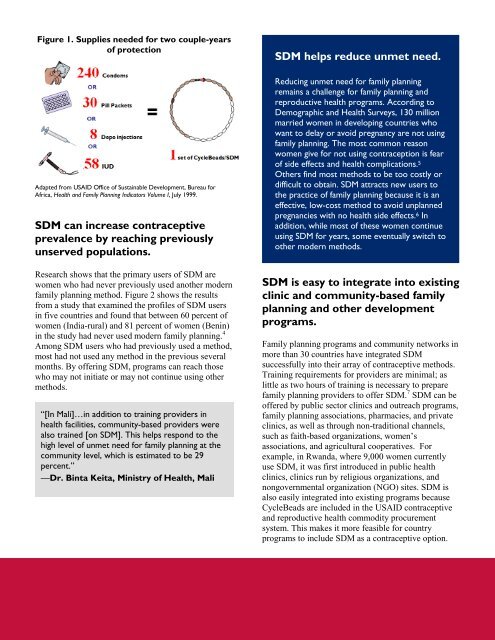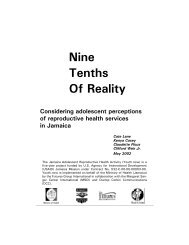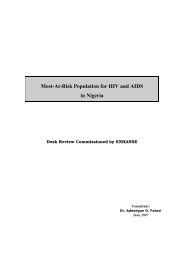3541FAM-SDM PolicyBrief.pdf - Futures Group
3541FAM-SDM PolicyBrief.pdf - Futures Group
3541FAM-SDM PolicyBrief.pdf - Futures Group
You also want an ePaper? Increase the reach of your titles
YUMPU automatically turns print PDFs into web optimized ePapers that Google loves.
Figure 1. Supplies needed for two couple-years<br />
of protection<br />
<strong>SDM</strong> helps reduce unmet need.<br />
Adapted from USAID Office of Sustainable Development, Bureau for<br />
Africa, Health and Family Planning Indicators Volume I, July 1999.<br />
<strong>SDM</strong> can increase contraceptive<br />
prevalence by reaching previously<br />
unserved populations.<br />
Research shows that the primary users of <strong>SDM</strong> are<br />
women who had never previously used another modern<br />
family planning method. Figure 2 shows the results<br />
from a study that examined the profiles of <strong>SDM</strong> users<br />
in five countries and found that between 60 percent of<br />
women (India-rural) and 81 percent of women (Benin)<br />
in the study had never used modern family planning. 4<br />
Among <strong>SDM</strong> users who had previously used a method,<br />
most had not used any method in the previous several<br />
months. By offering <strong>SDM</strong>, programs can reach those<br />
who may not initiate or may not continue using other<br />
methods.<br />
“[In Mali]…in addition to training providers in<br />
health facilities, community-based providers were<br />
also trained [on <strong>SDM</strong>]. This helps respond to the<br />
high level of unmet need for family planning at the<br />
community level, which is estimated to be 29<br />
percent.”<br />
—Dr. Binta Keita, Ministry of Health, Mali<br />
Reducing unmet need for family planning<br />
remains a challenge for family planning and<br />
reproductive health programs. According to<br />
Demographic and Health Surveys, 130 million<br />
married women in developing countries who<br />
want to delay or avoid pregnancy are not using<br />
family planning. The most common reason<br />
women give for not using contraception is fear<br />
of side effects and health complications. 5<br />
Others find most methods to be too costly or<br />
difficult to obtain. <strong>SDM</strong> attracts new users to<br />
the practice of family planning because it is an<br />
effective, low-cost method to avoid unplanned<br />
pregnancies with no health side effects. 6 In<br />
addition, while most of these women continue<br />
using <strong>SDM</strong> for years, some eventually switch to<br />
other modern methods.<br />
<strong>SDM</strong> is easy to integrate into existing<br />
clinic and community-based family<br />
planning and other development<br />
programs.<br />
Family planning programs and community networks in<br />
more than 30 countries have integrated <strong>SDM</strong><br />
successfully into their array of contraceptive methods.<br />
Training requirements for providers are minimal; as<br />
little as two hours of training is necessary to prepare<br />
family planning providers to offer <strong>SDM</strong>. 7 <strong>SDM</strong> can be<br />
offered by public sector clinics and outreach programs,<br />
family planning associations, pharmacies, and private<br />
clinics, as well as through non-traditional channels,<br />
such as faith-based organizations, women’s<br />
associations, and agricultural cooperatives. For<br />
example, in Rwanda, where 9,000 women currently<br />
use <strong>SDM</strong>, it was first introduced in public health<br />
clinics, clinics run by religious organizations, and<br />
nongovernmental organization (NGO) sites. <strong>SDM</strong> is<br />
also easily integrated into existing programs because<br />
CycleBeads are included in the USAID contraceptive<br />
and reproductive health commodity procurement<br />
system. This makes it more feasible for country<br />
programs to include <strong>SDM</strong> as a contraceptive option.







